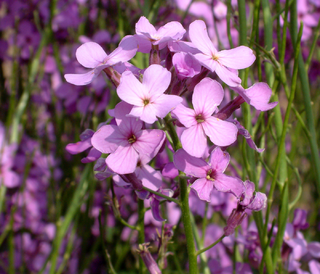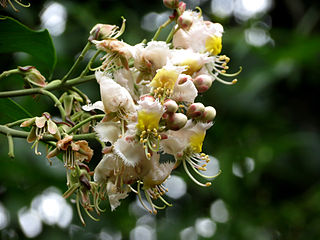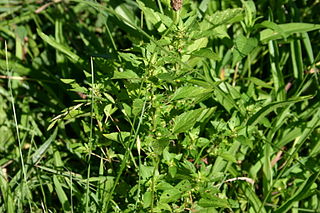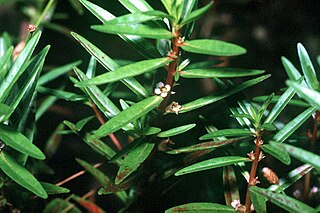
Carduus nutans, with the common names musk thistle, nodding thistle, and nodding plumeless thistle, is a biennial plant in the daisy and sunflower family Asteraceae. It is native to regions of Europe and Asia.

Cirsium vulgare, the spear thistle, bull thistle, or common thistle, is a species of the Asteraceae genus Cirsium, native throughout most of Europe, Western Asia, and northwestern Africa. It is also naturalised in North America, Africa, and Australia and is an invasive weed in some areas. It is the national flower of Scotland.

Hesperis matronalis is an herbaceous plant species in the family Brassicaceae. It has numerous common names, including dame's rocket, damask-violet, dame's-violet, dames-wort, dame's gilliflower, night-scented gilliflower, queen's gilliflower, rogue's gilliflower, summer lilac, sweet rocket, mother-of-the-evening, Good & Plenties, and winter gilliflower.

Spartium junceum, known as Spanish broom, rush broom, or weaver's broom, it is a species of flowering plant in the family Fabaceae and the sole species in the genus Spartium. It is closely related to the other brooms.

Canna indica, commonly known as Indian shot, African arrowroot, edible canna, purple arrowroot, Sierra Leone arrowroot, is a plant species in the family Cannaceae. It is native to much of South America, Central America, the West Indies, and Mexico. It is also naturalized in the southeastern United States, and much of Europe, sub-Saharan Africa, Southeast Asia, and Oceania. Canna indica has been a minor food crop cultivated by indigenous peoples of the Americas for thousands of years.

Ranunculus bulbosus, commonly known as bulbous buttercup or St. Anthony's turnip, is a perennial flowering plant in the buttercup family Ranunculaceae. It has bright yellow flowers, and deeply divided, three-lobed long-petioled basal leaves.

Rotala rotundifolia, the dwarf rotala, is a plant species often confused with Rotala indica. It is sold in the aquarium trade, but is of uncertain status.

Carduus pycnocephalus, with common names including Italian thistle, Italian plumeless thistle, and Plymouth thistle, is a species of thistle. It is native to: the Mediterranean region in southern Europe, North Africa, and Western Asia; East Europe and the Caucasus; and the Indian Subcontinent.

Ipomoea indica is a species of flowering plant in the family Convolvulaceae, known by several common names, including blue morning glory, oceanblue morning glory, koali awa, and blue dawn flower. It bears heart-shaped or 3-lobed leaves and purple or blue funnel-shaped flowers 6–8 cm (2–3 in) in diameter, from spring to autumn. The flowers produced by the plant are hermaphroditic. This plant has gained the Royal Horticultural Society's Award of Garden Merit.

Hiptage benghalensis, often simply called hiptage, is a perennial, evergreen liana native to India, Southeast Asia, Taiwan, and the Philippines. Its habitat is variable and prefers climates ranging from warm temperate to tropical. In Hawaii, where H. benghalensis is considered a weed, as it is in Australia, Mauritius and Réunion, it grows from sea level to 1,000 m (3,281 ft). H. benghalensis is cultivated for its white-pink scented flowers.

Acalypha rhomboidea is a plant in the spurge family, Euphorbiaceae.

Veronica serpyllifolia, the thyme-leaved speedwell or thymeleaf speedwell, is a perennial flowering plant in the plantain family. It is native to Europe, but can be found elsewhere on most continents as an introduced species.

Potentilla recta, the sulphur cinquefoil or rough-fruited cinquefoil, is a species of cinquefoil. It is native to Eurasia but it is present in North America as an introduced species, ranging through almost the entire continent except the northernmost part of Canada and Alaska.

Erysimum repandum is a species of Erysimum known by several common names, including spreading wallflower, spreading treacle-mustard, and bushy wallflower.

Kalimeris indica, also known as Indian aster or Indian Kalimeris, is a flowering herbaceous perennial plant of the family Asteraceae (Compositae). Kalimeris indica, like other species in the genus of Kalimeris, occurs mainly in eastern Asian countries of China, Korea and Japan, and has been introduced to California and Hawaii.

Rotala ramosior is a species of flowering plant in the loosestrife family known by the common name lowland rotala. This aquatic or semiaquatic plant is native to North America, where it grows in lakes, streams, and irrigation ditches. The branching stems of the plant grow to about 40 cm long. Leaves are decussate, arranged oppositely in perpendicular pairs along the stems. The leaves are linear to lance-shaped to oval and up to 5 cm long. Flowers occur singly in leaf axils. Each has triangular sepals with long, narrow appendages and usually four tiny white petals in shades of pink to white. This plant is sometimes grown in aquariums.

Scleranthus annuus is a species of flowering plant in the family Caryophyllaceae known by the common names German knotweed and annual knawel. It is native to Europe, Asia, and North Africa, and it is known throughout the rest of the temperate world as an introduced species and a common weed. It grows in many types of habitat, often in disturbed areas.

Silene gallica is a species of flowering plant in the family Caryophyllaceae known by several common names, including common catchfly, small-flowered catchfly, and windmill pink. It is native to Eurasia and North Africa, but it can be found throughout much of the temperate world as a common roadside weed.

Vigna marina is a prostrate, creeping vine and a perennial plant. Also known as the beach pea, nanea, and notched cowpea, it is a species of legume in the family Fabaceae.

Digitaria ciliaris is a species of grass known by the common names southern crabgrass, tropical finger-grass, tropical crabgrass or summer grass.




















